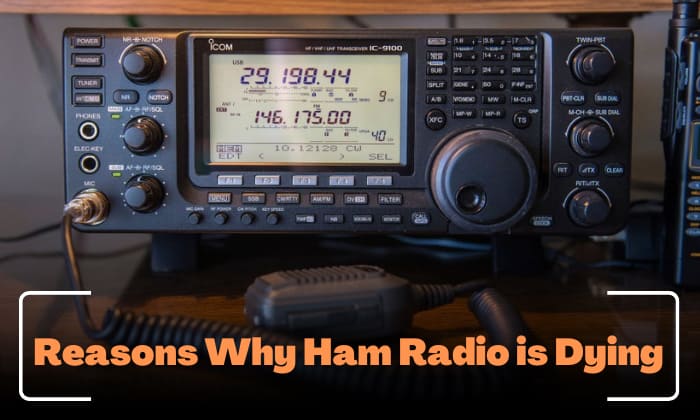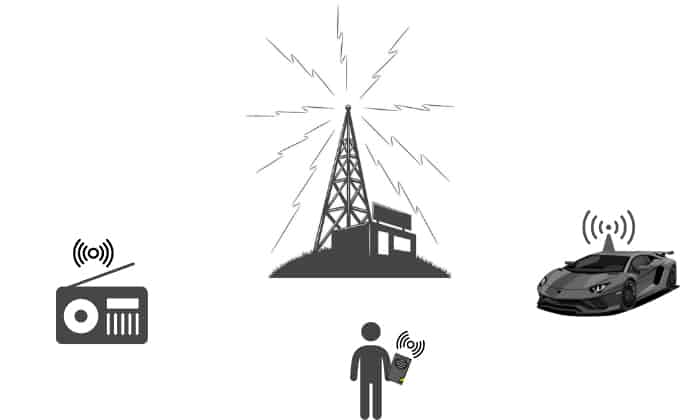Is ham radio dead? Definitely not, but there’s a possibility it will be so in the future. Our radios are dying for many reasons, which you’ll learn in this article.
Specifically, you’ll know that the reasons why ham radio is dying are mainly due to licensing difficulties and technological advancements like the Internet, along with other alternatives other than ham radio.
For a detailed discussion, continue reading for a more in-depth understanding of this topic.
Contents
Ham Radio History
Ham radios (amateur radio) have a rich history dating back to the late 19th century when it was invented by Guglielmo Marconi following the discovery of radio waves by Rudolf Hertz.
It was not long after that instruction for setting up such a system appeared in various magazines, with the earliest recorded success in 1904. By 1905, one could buy amateur radios that were commercially produced.
The late 1908 saw the foundation of the Wireless Association of America, which then published a book providing a roster of authorized amateur radio operators, along with their respective call signs.
Today, ham radio remains an essential part of the global communication infrastructure, and people still use ham radios as a hobby around the world.
How Does It Work?
Ham radio operators transmit signals over a range of frequencies, from HF to microwaves, to communicate globally. The transmission process involves encoding voice or data into an electrical signal and modulating it onto a carrier wave.
The carrier wave is transmitted and received by the station, which then extracts the original signal and outputs it as sound or data. Ham radio users can employ different modes like voice (AM, FM, SSB), digital modes (PSK31, RTTY, FT8), or Morse code.
The Purpose of Ham Radio
1. Emergency Communication
In times of crisis, when conventional communication channels like phone lines and cell towers may not be functioning properly, these devices can act as a way to communicate. This is because radio broadcasts are unlikely to be interrupted by natural disasters.
2. Homebrewing
Homebrewing, which involves designing and constructing radio equipment, is a popular activity among ham radio enthusiasts. This can include building antennas, as well as creating their own transmitters and receivers.
3. Communication among professionals
Radio communication is extensively employed by professionals in various fields. Two-way radios and other radio-based communication systems offer dependable and secure communication.
Reasons Why Ham Radios Are Dying
1. The increasing popularity of the Internet
With the growth of technology, people now prefer the Internet over ham radio because they can access a wide range of communication options that provide faster and more reliable means of communication.
For instance, social media platforms, email, and messaging apps offer real-time communication unrestricted by location. Such substitutes are more convenient and cost-effective, which may render a ham radio obsolete.
2. Licensing problems
Gaining a ham radio license involves completing a series of training and assessments, which can serve as a hurdle for several individuals. Moreover, renewing and sustaining the license necessitates ongoing education and expenses, leading to a significant investment of time and money.
These aspects may discourage individuals from considering ham radio as a recreational activity or communication method.
3. The emergence of electronics using Arduino
With the advent of electronic components, such as the Arduino microcontroller, constructing and managing communication devices has become more accessible. As a result, inexpensive alternatives to 2 meter ham radios have emerged that can produce comparable outcomes, if not better.
These substitutes are typically more user-friendly and less daunting than traditional ham radios, making them a more attainable option for individuals unfamiliar with communication technology. Additionally, some units may also provide no traffic ham radios, which can lead to a decline in the popularity of traditional ham radios.
What Does a Dying Ham Radio Mean?
A dying ham radio refers to the declining popularity and usage of ham radio communication over time. That said, it does not necessarily mean that ham radio has already died off or that people are already not using it. Many users still rely on ham radios as means of their communication, especially in times of emergencies.
However, the above-mentioned reasons, such as the Internet, licensing, and more advanced communication technologies, have deterred people from pursuing ham radio as a hobby or way of communication.
Frequently Asked Questions
Is ham radio still useful?
Definitely, yes! Ham radio is still useful today and even in the future.
Although the usage and popularity of ham radio have dwindled over time due to the emergence of more advanced digital communication technologies, there are still many situations where ham radio is a valuable communication tool.
Particularly, this is useful during emergencies when other communication methods are not available and in remote locations with poor internet or cellular network coverage. It is also a hobby that allows individuals to connect globally and engage in community events.
Is ham radio growing?
Given the existing data, it is challenging to determine that the growth of ham radio is considerable. The number of authorized amateur radio operators in the United States is around 750,000, which has remained relatively constant in recent years.
However, some claim that it is growing at a 1% rate, which means it increases by approximately 7 500 licensed operators each year that passes. Although any progress is favorable, this pace is quite modest and would not significantly increase the total number of licensed operators.
Moreover, it is essential to recognize that growth rates can vary depending on various reasons, including technological advancements, regulatory policies, and cultural trends. Therefore, even though ham radio is not currently encountering any drastic surge in popularity, it is feasible that this could change in the future.
Conclusion
So, is your ham packet radio dead today? No, right? It still can be useful, as we explained above.
Hopefully, after learning the reasons why ham radio is dying, you won’t be deterred from pursuing the hobby. After all, there can be a chance, however small, that ham radios will make a comeback in the future.

Hello! I am Hart, the content writer and editor here at G0HWC. I used to be in the same local radio club with Howe, and he convinced me to join him in spreading my love for the radio with others. With a background in radio studies, I spend every day crafting accurate, easy to read content on various topics related to owning and using radios. I hope that my content can help you confidently venture in your radio journey!







